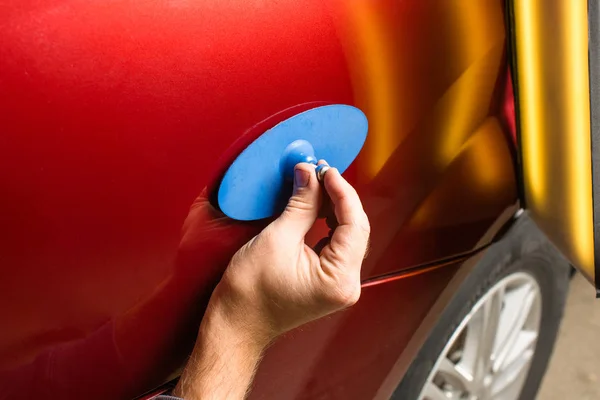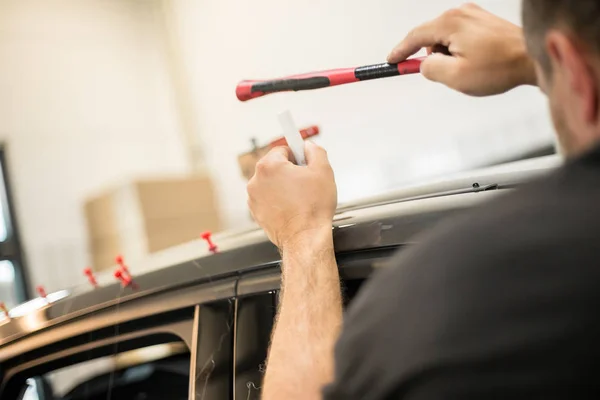Unveiling The Secrets Behind Professional Auto Dent Repair Techniques!
PDR specialists utilize specific tools that are tailored to their work. These instruments are vital for accessing hard-to-reach spots and applying the appropriate pressure to repair dents without causing further damage. An expert technician is skilled in the effective use of each tool, which is key to obtaining flawless outcomes.
Understanding the Basics of Auto Dent Repair
Repairing dents in vehicles is a more intricate process than it first seems. Although it might look like an easy task to just push the dent out, experts employ a variety of specialized tools and methods to meticulously restore the car's surface while preserving the paint and maintaining its structural integrity. Below is a summary of how this procedure unfolds:
The Different Types of Car Dents
Dents come in various forms. To grasp the process of professional repair, it’s important to recognize the different types of dents that can impact your vehicle:
- Round Dents: Result from impacts by items such as hail or minor collisions.
- Crease Dents: Formed when a pointed object creates an elongated, slender indentation.
- Sharp Dents: Usually arise from accidents or encounters with rigid objects.
Every kind of dent necessitates a unique repair technique, making it essential to rely on professionals who can identify the appropriate method.
The Importance of Assessing Paint Damage
A crucial element of professional dent repair involves evaluating the condition of the paint. Should there be any chips or cracks in the paint, addressing the dent might necessitate additional steps beyond simple removal. Experts need to determine if paintless dent repair (PDR) can be applied or if conventional body shop techniques will be required.

Common Professional Dent Repair Techniques
Let's examine the various techniques that experts typically employ to fix dents. Each method offers unique benefits and is selected according to the nature and extent of the damage.
Paintless Dent Repair (PDR)
Paintless Dent Repair (PDR) stands out as the most favored and commonly employed technique in the field. This approach entails skillfully adjusting the dent from the rear of the panel, allowing for the restoration of the vehicle's exterior without affecting the paint finish. Here's an overview of its process:
- Gaining Entry to the Dent: The technician will detach or ease adjacent panels, headlights, or taillights to reach the rear side of the dent.
- Utilizing Specialized Equipment: A selection of metal rods and body picks is employed to gently push the dent out from within, restoring the panel to its original shape.
- No Repainting Required: Since paintless dent repair (PDR) preserves the existing paintwork, repainting is unnecessary, resulting in a faster and more cost-effective solution.
This technique works exceptionally well for small to medium dents, particularly when the paint is still in good condition. It is a highly effective procedure that can be finished within a matter of hours. Discover more here.
Traditional Body Shop Repair
In cases of significant or deep dents, particularly when the paint is also compromised, it is essential to seek repairs from a conventional body shop. The procedure includes:
- Repairing and Smoothing: When a dent results in paint damage, a body filler is applied to the impacted region to create a level surface. After it dries, the filler is sanded to ensure it aligns with the rest of the vehicle's exterior.
- Priming and Coating: After achieving a smooth finish, the area receives primer and fresh paint to ensure it integrates well with adjacent sections.
- Finishing Touches: Finally, a polish is used post-painting to guarantee that the repaired area closely resembles the car's original appearance.
Although this method is time-consuming and costlier, it remains the most effective choice for addressing serious dents or substantial damage from accidents.
Insider Tips for a Successful Auto Dent Repair
Mastering the art of professional auto dent repair requires years of experience, yet there are certain tips and tricks that everyday car owners can also take advantage of.
Address Dents Quickly
It’s crucial to address dents promptly. Delaying the repair increases the risk of rust forming, particularly if the dent has revealed the bare metal beneath the paint. Rust can escalate rapidly, resulting in more extensive damage that could necessitate costly repairs.
Use Quality Repair Services
Selecting a trustworthy repair shop is crucial for achieving optimal outcomes. Seek out certified professionals who are skilled in both paintless dent repair (PDR) and conventional techniques. A top-notch repair service will not only eliminate the dent but also preserve your vehicle's integrity and value.
Understand Your Insurance Coverage
Before hurrying to fix your dent, it's wise to consult your car insurance company to determine if the damage is included in your policy. A lot of insurance plans offer coverage for dent repairs, particularly when they result from accidents or similar events. Understanding your coverage can lead to substantial savings on repair expenses.

The Cost of Professional Auto Dent Repair
The price for professional dent repair can fluctuate based on various elements, including the dent's size, its position, and how severe it is. Typically:
The expense for minor dents can vary from $100 to $500 when utilizing Paintless Dent Repair (PDR). For more significant dents that necessitate bodywork and repainting, costs can escalate from $500 to over $2,500. To secure the most favorable pricing, it's advisable to obtain quotes from several repair shops; however, it is essential to emphasize the importance of quality over cost.
When to Attempt DIY Dent Repair
Although most dent repairs are usually managed by experts, there are occasions when small dents can be addressed at home through do-it-yourself techniques. Below are some situations where DIY dent repair might be feasible:
Small and Shallow Dents
For minor dents that don't affect the paint, you might find success with do-it-yourself techniques such as employing a hairdryer along with compressed air or utilizing a dent puller. Nonetheless, exercise care to prevent any additional harm.
Accessible Locations
Dents located in accessible spots like the hood or doors are simpler for do-it-yourself enthusiasts to handle. In contrast, more intricate dents found in less reachable areas should ideally be addressed by experts.
110 E 43rd St, Suite 120
Garden City, Idaho 83714, USA
Phone: (208)-251-5338

